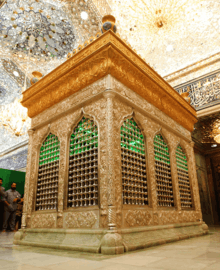Ibrahim al-Mujab
Sayyid Ibrāhīm ibn Muḥammad ibn Musā al-Kādhim (Arabic: إبْرَاهِيم بْنِ مُحَمَّد بْنِ مُوسَى الكَاظِمْ) also known as Ibrahim al-Mujab and al-Dharir al-Kufi, was the son of Muhammad al-Abid, and grandson of Musa al-Kadhim, the seventh Twelver Shia Imam.[1][2][3][4] He was the first Alid to settle in Karbala, where he died, and was buried in the Imam Husayn shrine.[5]
Ibrahim al-Mujab | |
|---|---|
إبراهيم بن محمد المجاب | |
 al-Mujab's shrine inside the Husayn Shrine precinct | |
| 1st Custodian of the Imam Husayn Shrine | |
| In office 861–912 | |
| Preceded by | position established |
| Succeeded by | Mohammad al-Haeri |
| Other names | Taj al-Din (تَاجْ الدِّينْ) |
| Personal | |
| Died | 912 |
| Resting place | Imam Husayn Shrine |
| Religion | Islam |
| Children | 2 |
| Parents |
|
| Denomination | Shīʿā |
| Known for | First Alid to settle in Karbala |
| Other names | Taj al-Din (تَاجْ الدِّينْ) |
| Relatives | Musa al-Kadhim (grandfather) Ali al-Ridha (uncle) |
al-Mujab has many descendants that are known today by various names. Al Faiz is the only line of his that remained in Karbala until this day, since he settled in 861.[6] As for his other descendants, most of them emigrated to other cities and countries, some of them are known today as Al Qazwini, Al Hamami, Al Sabziwari, and Al Khirsan.[7][3] It is also reported, that al-Sharif al-Radhi and al-Murtadha are descendants of al-Mujab.[8]
Biography
The date and place of al-Mujab's birth are unknown.
al-Mujab migrated from Kufa to Karbala in 861, after the Abbasid caliph al-Mutawakkil was killed at the hands of his son, al-Muntasir. al-Muntasir was more merciful towards the Shias, and sympathetic with the Alids, allowing them to freely visit the grave of Husayn.[9]
al-Mujab became the first custodian of the Husayn and Abbas shrines.[10]
It is reported that when al-Mujab entered the shrine of Husayn, he called, "Peace be upon you, O' father" to which he received an answer from the grave in a loud voice; "and with you be peace, O' my son"; and thus, became known as al-mujab, meaning "the answered one".[11]
One of his descendants recorded the incident in poetry, stating[4][12]:
مِـنْ أيْـنَ لِلْنَــاسِ مِثْــلُ جَـدِّي |
From where do the people have the like of my grandfather; |
Death and resting place
al-Mujab died in Karbala, in 912. He was buried in the grand courtyard of the Husayn shrine.[13]
In 1804, al-Mujab's grave and rawaq (hallway) were added to the north west side of the Husayn shrine's precinct, under the supervision of the shrines' custodian at the time, Jawad Nasrallah, as part of an expansion of the Husayn shrine.[14]
The cage above his grave was renewed in 2013, by the Iranian association responsible for religious sites in Iraq.[15]
References
- Fuda, Ali (2016-01-01). al-Mashjar al-Mubasat Fi Ansab al-Hasan Wa al-Husayn [Simplified Trees In The Descendants of Hasan and Husayn] (in Arabic). 2. Dar al-Kutub. p. 83. ISBN 978-977-6445-70-3.
- al-Madani, Dhamin bin Shadqam. Tuhfat al-Azhar Wa Zulal al-Anhar Fi Nasab al-A'imah al-Athar [Vase of Flowers and Heavenly Rivers of The Lineages of The Imams] (in Arabic). 3. p. 280.
- Abu Zaid al-Ameli, Ahmed (2007). Muhammad Baqir al-Sadr: al-Sira Wal Masira Fi Haqaeq Wa Wathaeq (in Arabic). 1. Beirut, Lebanon: Musasat al-Aref Lil Matboo'at. p. 17.
- Abu S'eeda al-Musawi, Husayn (2004). al-Mashjar al-Waafi [The Loyal Tree]. 1. Beirut, Lebanon: Mu'asasat al-Balagh. pp. 494–95.
- Hussain, Abu Sa'ida (2005). Tarikh al-Mashhahid al-Mushrifa [History of the Honourable Shrines] (in Arabic). Moesasat al-Balagh. p. 39.
- al-Husayni 'Naqeeb Halab', Taj al-Din (1893). Ghayat al-Ikhtisar Fi al-Buyutat al-Alawiya al-Mahfoodha Min al-Ghubar [Extremely Brief Alid Households Protected From Dust] (PDF) (in Arabic). Egypt. p. 88.
- al-Husayni 'Naqeeb Halab', Taj al-Din (1893). Ghayat al-Ikhtisar Fi al-Buyutat al-Alawiya al-Mahfoodha Min al-Ghubar [Extremely Brief Alid Households Protected From Dust] (PDF) (in Arabic). Egypt. pp. 190–92.
- Ṭūsī, Muḥammad ibn al-Ḥasan (1964). Amālī al-Shaykh al-Ṭūsī (in Arabic). al-Maktabah al-Ahlīyah. p. 9.
- Melchert, Christopher (1996). "Religious Policies of the Caliphs from al-Mutawakkil to al-Muqtadir, A H 232-295/A D 847-908". Islamic Law and Society. 3 (3): 330–331. doi:10.1163/1568519962599069. ISSN 0928-9380. JSTOR 3399413.
- al-Karbassi, Dr. Shaykh Mohammed Sadiq (2014-02-01). Tarikh al-Sidana al-Husayniya [History of the Husayni Custodianship] (in Arabic). London, UK: Hussaini Charitable Trust. p. 55. ISBN 978-1-908286-99-4.
- al-Husayni 'Naqeeb Halab', Taj al-Din (1893). Ghayat al-Ikhtisar Fi al-Buyutat al-Alawiya al-Mahfoodha Min al-Ghubar [Extremely Brief Alid Households Protected From Dust] (in Arabic). Egypt. pp. 89–90.
- Ṭuʻmah, Salmān Hādī (1964). Turath Karbala [Heritage of Karbala] (in Arabic). Beirut, Lebanon: Muʼassasat al-Aʻlamī. p. 76.
- Baḥr al-ʻUlūm, Muḥammad Mahdī (1965). al-Fawa'id al-Rijaliya [The Benefits of the Men of Narrations] (in Arabic). Matba'at al-Adaab. p. 114.
- al-Karbassi, Ayatollah Dr. Mohammed Sadiq (2002-12-01). Tarikh al-Maraqid (al-Husayn, Wa Ahli Baytih, Wa Ansarih) [History of the Shrines (Husayn, His family, and his Companions)] (in Arabic). 2. London, UK: Hussaini Centre for Research. p. 122. ISBN 978-1-902490-25-0.
- al-Karbassi, Muhammad-Sadiq (2015-05-01). Tarikh al-Maraqid (al-Husayn Wa Ahl Baytih Wa Ansarih) (in Arabic). 8. London, UK: Hussaini Centre for Research. p. 68. ISBN 978-1-78403-000-1.